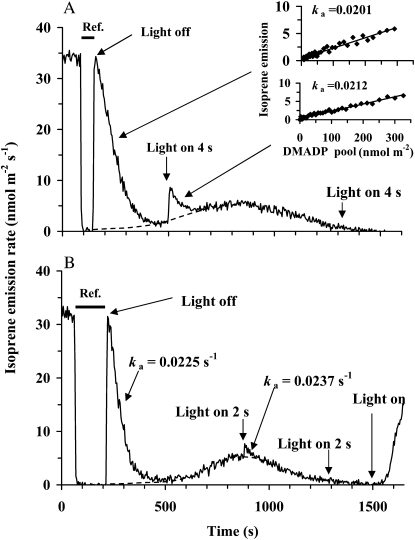Figure 1.
Illustration of the protocol for the measurement of steady-state isoprene emission rate of illuminated samples and transient isoprene release after rapid leaf darkening, and the effect of light pulses during the dark transient phase on isoprene emission in hybrid aspen. A fast two-channel gas-exchange system with a half-response time of 0.15 s was employed (Rasulov et al., 2010). The applied measurement protocol was similar for both the experiments in A and B, except for different timing of light pulses given in the darkness. In A, the recording begins in the steady-state conditions. At time 100 s, the reference line was recorded by switching between the reference and sample lines (shown by a horizontal bar). At 130 s, light was turned off, and the leaf chamber was simultaneously returned into the measurement channel. The following isoprene emission was recorded in the dark. In B, the steady-state isoprene emission rate in light is shown between 0 and 85 s, and the reference is measured between 85 and 210 s. The dotted line is the assumed activation time course of the dark-induced isoprene emission. The inset in A demonstrates an estimation of the rate constant of isoprene synthase (ka; s−1) for the periods 290 to 400 s and 500 to 600 s. The rate constant was determined from the relationships of isoprene emission rate (I) at time t1 versus the pool size of DMADP remaining at t1 (for further details, see Eq. 2 and Rasulov et al., 2010). The corresponding rate constants of isoprene synthase (ka; s−1) are also shown. In both experiments, quantum flux density during the light period was 600 μmol m−2 s−1, leaf temperature was maintained at 33°C, ambient CO2 concentration at 360 μmol mol−1, and oxygen concentration at 21%.

